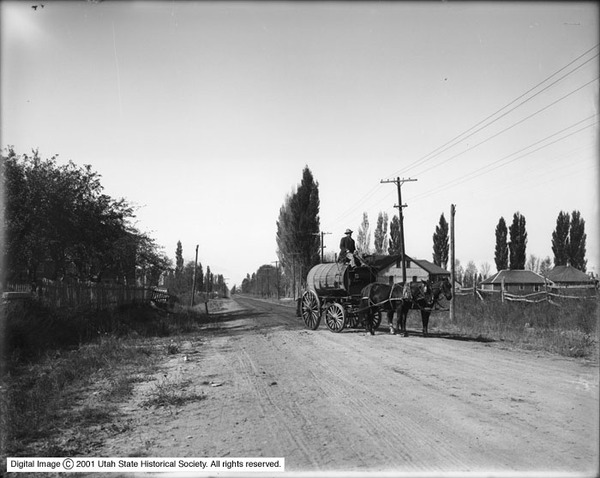Dublin Core
Title
Description
During the early 1900s, Box Elder County’s town, Corinne, was growing fast. More traffic along the dirt roads meant horses and wagons kicked a thick layer of dust into the air. Clouds of earth poured into homes through windows and doors, sometimes making interior spaces practically unlivable. Summers were especially rough and requests from residents flooded in for sprinkling wagons to pack down the earth and prevent dust from spreading. Urban dwellers were impacted by the dirty air, but the amount of water needed to curb the problem was significant.
Water wagons, massive wooden tanks on four wheels, were pulled by two horses through the main thoroughfares of Corinne and other Utah towns. Drivers sat perched atop a spring seat, controlling the flow of water with foot pedals. The tanks sprinkled water along the earth, helping to pack down the dirt and prevent large clouds of dust from infiltrating homes and harming the quality of life in developing towns. When the driver needed to refill the tank, he would simply find the nearest fire hydrant and use a firehose to fill the barrel.
Water wagons required hundreds of gallons of water, and concern over water supply dominated conversations about road maintenance in local papers. Ordinances about sprinkling and refilling water wagons attempted to control some of the water usage, but during the dry summer months residents complained the roads were still too dusty. Women complained that the dirty air prevented them from hanging their laundry out to dry. Local business owners felt that dusty air was simply the price to pay for industry, arguing that it was quote “better to have business and dust than solitude and clean air.”
Within just a few decades the struggle over sprinkling wagons resolved itself. Packed dirt gave way to paved roads, eliminating the problem of dust and allowing for easier travel as the automobile became more widely available. However, this struggle was just the beginning for Utahns learning to navigate the delicate balance between water usage, human health, and growing industry.
Creator
Source
_______________
See: Brigham D. Madsen, Corinne - The Gentile Capital of Utah, 1980; Glen M. Leonard, History of Davis County (Salt Lake City: Utah Historical Society, 1999), 289-293; C. Ray Balmforth, “Horses, Wagons, Drivers, Kids,” Beehive History 8 (1982): 16-17.; “A Boorish Sprinkler,” Deseret Evening News, April 29, 1891.; “Muddy Streets,” Salt Lake Herald-Republican, October 7, 1888.; Alberta Carriage Supply, “Restoring a Piece of History to Get it Back to Work,”.

